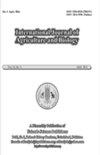Identification of Promising Genotypes and Discriminating Traits under Salt Stress at Early Growth Stages of Maize
Q2 Agricultural and Biological Sciences
引用次数: 0
Abstract
Salinity stress is one of the leading abiotic stresses seriously affecting the crop productivity across the world. Early growth stages are more affected by salinity stress than terminal growth stages. Therefore, maize genotypes were evaluated for their performance in three different studies (Experiment-1: irrigation of seeds with salt solutions (distilled water, 4 dS/m, 6 dS/m and 10 dS/m) for 5 days, Experiment-2: application of different salinity treatments (distilled water, 4 dS/m, 6 dS/m and 10 dS/m) for 20 days from sowing to seedling emergence stage, Experiment-3: application of salinity stresses in hydroponic culture under four above mentioned different salinity treatments. Time to start germination (TSG), time to 50% germination (TFG) and final germination percentage (FGP) of the maize genotypes was reduced by salinity stress. Radicle length, plumule length, root and shoot length and fresh weight and chlorophyll contents were also linearly reduced in maize genotypes by increasing salinity levels. Moreover, sodium (Na+) concentration was increased in seeds and seedlings of maize genotypes whereas; potassium (K+) concentration was reduced with gradual rise in salinity levels. Principal Component Analysis (PCA) biplots facilitated the efficient assortment of susceptible, moderately susceptible, moderately tolerant and tolerant maize genotypes for each of the three studies separately. Genotype „YS-2008‟ was susceptible for seed treatment and hydroponic studies whereas, genotype „T267-5‟ was susceptible for early seedling and hydroponic studies. Genotype „C864-284‟ was tolerant in early seedling and hydroponic studies. The GGE biplot analysis indicated that „YS-2008‟ genotype was susceptible for salinity stress. Under hydroponic conditions, genotypes could effectively be discriminated by the imposition of severe salt stress (10 dS/m); however, under seed treatments and early seedling growth stages, mild stress treatments (4 dS/m) were sufficient enough to discriminate the maize genotypes. Hydroponic evaluation of genotypes is suitable and preferable under high stress conditions at early growth stages. Identified tolerant and susceptible genotypes could be effectively used in different breeding programs to develop salt tolerant new cultivars for commercial purposes. © 2021 Friends Science Publishers玉米生长早期盐胁迫下前景基因型及鉴别性状的鉴定
盐胁迫是严重影响作物生产力的主要非生物胁迫之一。生长前期受盐度胁迫的影响大于生育末期。因此,本研究对玉米基因型进行了3个不同研究,分别为试验1:用盐溶液(蒸馏水,4 dS/m, 6 dS/m和10 dS/m)灌溉种子5 d,试验2:从播种到出苗期,施用不同盐度处理(蒸馏水,4 dS/m, 6 dS/m和10 dS/m) 20 d,试验3:在上述4种不同盐度处理下对水培施加盐度胁迫。盐胁迫降低了玉米基因型的发芽期(TSG)、50%发芽期(TFG)和最终发芽率(FGP)。根长、胚芽长、根冠长、鲜重和叶绿素含量也随盐度的增加而线性降低。此外,钠(Na+)浓度在玉米基因型种子和幼苗中升高;钾(K+)浓度随盐度水平的逐渐升高而降低。主成分分析(PCA)双标图促进了三个研究中易感、中易感、中耐和耐玉米基因型的有效分类。基因型“YS-2008”对种子处理和水培研究敏感,而基因型“T267-5”对早苗和水培研究敏感。基因型“C864-284”在早苗和水培试验中表现出耐受性。GGE双图分析表明,“YS-2008”基因型对盐胁迫敏感。在水培条件下,盐胁迫(10 dS/m)可以有效地区分基因型;但在种子处理和幼苗生长早期,轻度胁迫处理(4ds /m)足以区分玉米基因型。在生长早期的高胁迫条件下,水培评价基因型是适宜的。鉴定出的耐盐和敏感基因型可以有效地应用于不同的育种计划中,培育出具有商业用途的耐盐新品种。©2021朋友科学出版社
本文章由计算机程序翻译,如有差异,请以英文原文为准。
求助全文
约1分钟内获得全文
求助全文
来源期刊

International Journal of Agriculture and Biology
AGRICULTURE, MULTIDISCIPLINARY-
CiteScore
1.70
自引率
0.00%
发文量
40
审稿时长
5 months
期刊介绍:
Information not localized
 求助内容:
求助内容: 应助结果提醒方式:
应助结果提醒方式:


